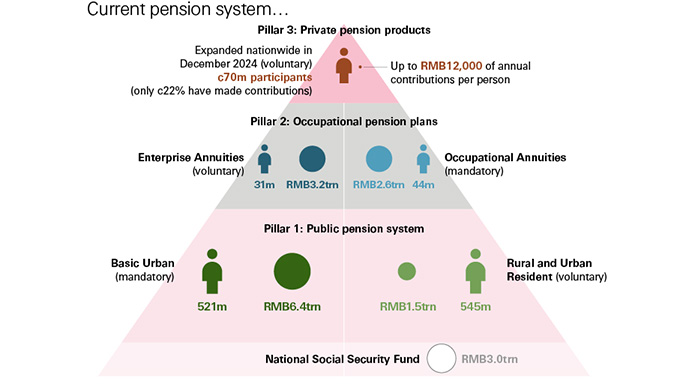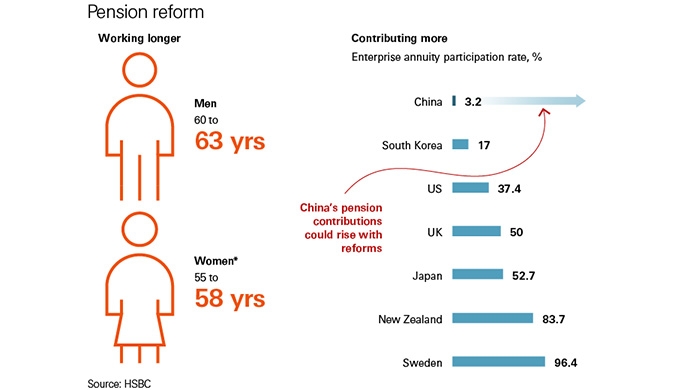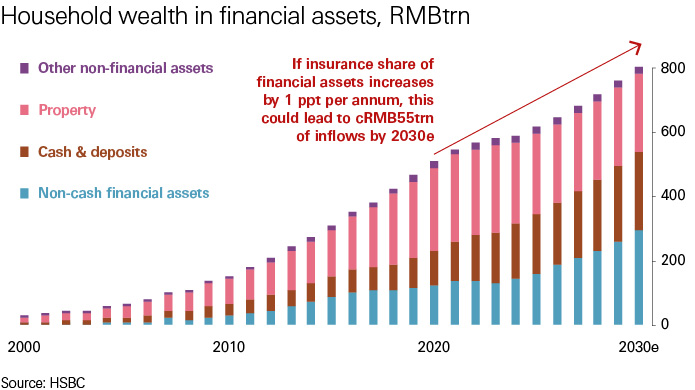- Article

- Global Research
- General Research Insights
- Demographics
China’s pension reform
China’s pension reform: Bolder measures needed to bridge the funding gap
- An ageing population and low interest rates are posing challenges to China’s pension system
- Raising the retirement age will move the needle, but we think bolder steps are needed
- China’s huge pile of household wealth can help – RMB55trn could flow into insurance and pension products by 2030
The problems. An ageing population and a low interest rate environment are the two main challenges facing China’s pension system (many other countries have the same problems). Other issues include urban-rural disparities, regional funding imbalances, and limited pension options.
Incremental reforms to bridge the funding gap. In Q4 2024, China announced an increase in the retirement age and rolled out private pensions nationwide. The government has also transferred shares from state-owned companies to the National Social Security Fund to bridge funding gaps in the state pension system, which covers about 1.1bn people.
Bolder steps needed to re-engineer the system. We think further reforms are needed to address gaps in coverage and aid the transition towards sustainable and more transparent pension models. In the experience of other countries, a partial shift from defined benefit schemes to defined contribution schemes is often inevitable. Given the complexity of pension reforms, early planning is preferred to avoid overburdening either the state or private employers. We look at examples in the Netherlands and Chile and suggest re-engineering Pillar 1 (the state pension) and Pillar 2 (employer sponsored pensions) by balancing guaranteed benefits with individual savings plans.
Channelling China’s vast household wealth into pension savings. Based on our estimates for 2024, Chinese household wealth totals cRMB600trn, with c30% in cash and deposits and c44% in real estate. In the next few years, we expect to see a strategic reallocation towards non-cash financial assets, particularly under-allocated private pension and insurance products. By 2030, we estimate household wealth will rise to RMB800trn, with RMB55trn flowing into insurance and pension products.
Would you like to find out more? Click here to read the report. Please note, you must be a subscriber to HSBC Global Research to access this link.
Dig deeper: Listen to Under the Banyan Tree, as Herald van der Linde sits down with Prerna Garg to discuss what mainland Chinese savers could do with a mind-bending USD22trn in savings, and what that could imply for markets at home and beyond. Available on Apple Podcasts, Spotify or wherever you get your podcasts.
To learn more about HSBC Global Research, including how to subscribe, email us at AskResearch@hsbc.com

HSBC Global Investment Summit
Our second Global Investment Summit took place in Hong Kong 25 to 27 March 2025. Explore expert insights and thought provoking dialogue on pressing opportunities and challenges with experts and leaders from around the world.
The following analyst(s), who is(are) primarily responsible for this document, certifies(y) that the opinion(s), views or forecasts expressed herein accurately reflect their personal view(s) and that no part of their compensation was, is or will be directly or indirectly related to the specific recommendation(s) or views contained in this research report: Jing Liu
This document has been issued by the Research Department of HSBC.
HSBC and its affiliates will from time to time sell to and buy from customers the securities/instruments, both equity and debt (including derivatives) of companies covered in HSBC Research on a principal or agency basis or act as a market maker or liquidity provider in the securities/instruments mentioned in this report.
Analysts, economists, and strategists are paid in part by reference to the profitability of HSBC which includes investment banking, sales & trading, and principal trading revenues.
Whether, or in what time frame, an update of this analysis will be published is not determined in advance.
For disclosures in respect of any company mentioned in this report, please see the most recently published report on that company available at www.hsbcnet.com/research.
Additional disclosures
- This report is dated as at 02 June 2025.
- All market data included in this report are dated as at close 28 May 2025, unless a different date and/or a specific time of day is indicated in the report.
- HSBC has procedures in place to identify and manage any potential conflicts of interest that arise in connection with its Research business. HSBC's analysts and its other staff who are involved in the preparation and dissemination of Research operate and have a management reporting line independent of HSBC's Investment Banking business. Information Barrier procedures are in place between the Investment Banking, Principal Trading, and Research businesses to ensure that any confidential and/or price sensitive information is handled in an appropriate manner.
- You are not permitted to use, for reference, any data in this document for the purpose of (i) determining the interest payable, or other sums due, under loan agreements or under other financial contracts or instruments, (ii) determining the price at which a financial instrument may be bought or sold or traded or redeemed, or the value of a financial instrument, and/or (iii) measuring the performance of a financial instrument or of an investment fund.
Issuer of report
The Hongkong and Shanghai Banking Corporation Limited
This document has been issued by The Hongkong and Shanghai Banking Corporation Limited, which has based this document on information obtained from sources it believes to be reliable but which it has not independently verified. Neither The Hongkong and Shanghai Banking Corporation Limited nor any member of its group companies (“HSBC”) make any guarantee, representation or warranty nor accept any responsibility or liability as to the accuracy or completeness of this document and is not responsible for errors of transmission of factual or analytical data, nor is HSBC liable for damages arising out of any person’s reliance on this information. The information and opinions contained within the report are based upon publicly available information at the time of publication, represent the present judgment of HSBC and are subject to change without notice.
This document is not and should not be construed as an offer to sell or solicitation of an offer to purchase or subscribe for any investment or other investment products mentioned in it and/or to participate in any trading strategy. It does not constitute a prospectus or other offering document. Information in this document is general and should not be construed as personal advice, given it has been prepared without taking account of the objectives, financial situation or needs of any particular investor. Accordingly, investors should, before acting on it, consider the appropriateness of the information, having regard to their objectives, financial situation and needs. If necessary, seek professional investment and tax advice.
The decision and responsibility on whether or not to purchase, subscribe or sell (as applicable) must be taken by the investor. In no event will any member of the HSBC group be liable to the recipient for any direct or indirect or any other damages of any kind arising from or in connection with reliance on any information and materials herein.
Past performance is not necessarily a guide to future performance. The value of any investment or income may go down as well as up and you may not get back the full amount invested. Where an investment is denominated in a currency other than the local currency of the recipient of the research report, changes in the exchange rates may have an adverse effect on the value, price or income of that investment. In case of investments for which there is no recognised market it may be difficult for investors to sell their investments or to obtain reliable information about its value or the extent of the risk to which it is exposed. Some of the statements contained in this document may be considered forward looking statements which provide current expectations or forecasts of future events. Such forward looking statements are not guarantees of future performance or events and involve risks and uncertainties. Actual results may differ materially from those described in such forward-looking statements as a result of various factors.
This document is for information purposes only and may not be redistributed or passed on, directly or indirectly, to any other person, in whole or in part, for any purpose. The distribution of this document in other jurisdictions may be restricted by law, and persons into whose possession this document comes should inform themselves about, and observe, any such restrictions. By accepting this report, you agree to be bound by the foregoing instructions. If this report is received by a customer of an affiliate of HSBC, its provision to the recipient is subject to the terms of business in place between the recipient and such affiliate. The document is intended to be distributed in its entirety. Unless governing law permits otherwise, you must contact a HSBC Group member in your home jurisdiction if you wish to use HSBC Group services in effecting a transaction in any investment mentioned in this document.
Certain investment products mentioned in this document may not be eligible for sale in some states or countries, and they may not be suitable for all types of investors. Investors should consult with their HSBC representative regarding the suitability of the investment products mentioned in this document.
HSBC and/or its officers, directors and employees may have positions in any securities in companies mentioned in this document. HSBC may act as market maker or may have assumed an underwriting commitment in the securities of companies discussed in this document (or in related investments), may sell or buy securities and may also perform or seek to perform investment banking or underwriting services for or relating to those companies and may also be represented on the supervisory board or any other committee of those companies.
From time to time research analysts conduct site visits of covered issuers. HSBC policies prohibit research analysts from accepting payment or reimbursement for travel expenses from the issuer for such visits.
The Hongkong and Shanghai Banking Corporation Limited is regulated by the Hong Kong Monetary Authority.
© Copyright 2025, The Hongkong and Shanghai Banking Corporation Limited, ALL RIGHTS RESERVED. No part of this publication may be reproduced, stored in a retrieval system, or transmitted, on any form or by any means, electronic, mechanical, photocopying, recording, or otherwise, without the prior written permission of insert issuing entity name. MDDI (P) 005/01/2025, MDDI (P) 006/09/2024, MDDI (P) 004/10/2024, MDDI (P) 020/10/2024





